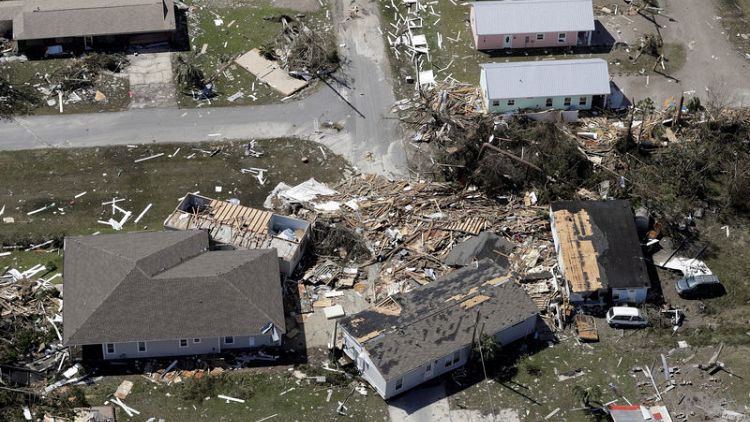By Devika Krishna Kumar
PORT ST. JOE, Fla. (Reuters) - Hurricane Michael's violence was visible on Thursday in shattered Florida coastal towns, where rows of homes were ripped from foundations and roofs were peeled off schools by the near-record-force storm blamed for seven deaths.
Michael smashed into Florida's northwest coast near the small town of Mexico Beach on Wednesday with screeching 155 mile per hour (250 kilometre per hour) winds, pushing a wall of seawater inland.
"The wind was really tearing us apart. It was so scary you’d poo yourself,” said retiree Tom Garcia, 60, who was trapped inside his Mexico Beach home as water poured in to waist height.
He and his partner Cheri Papineau, 50, pushed on their door for an hour to stop the storm surge bursting in as their four dogs sat on top of a bed floating in their home.
Video shot by CNN from a helicopter showed homes closest to the water in Mexico Beach had lost all but their foundations. A few blocks inland, about half the homes were reduced to piles of wood and siding and those still standing had suffered heavy damage.
Michael, the third most powerful hurricane ever to hit the U.S. mainland, weakened overnight to a tropical storm but marched northeast on Thursday, toppling trees with 50 mph (80 kph) winds and bringing "life threatening" flash flooding to Georgia and Virginia, the National Hurricane Center (NHC)reported.
At least seven people were killed by the storm in Florida, Georgia and North Carolina from falling trees and other hurricane-related incidents, according to state officials.
Gulf Coast Regional Medical Center in hard-hit Panama City, 20 miles (32 km) northwest of Mexico Beach, was treating some of the injured. The hospital was evacuating 130 patients as it faced challenges of running on generators after the storm knocked out power, ripped off part of its roof and smashed windows, a spokesman for the hospital's owner HCA Healthcare <HCA.N> said in an email.
Much of Port St. Joe, 12 miles (19 km) east of Mexico Beach, was underwater after Michael hit with 155 mph winds, snapping boats in two and hurling a large ship onto the shore, residents said. Only first responders were allowed in and an 8 pm curfew was imposed.
DAMAGE 'WAY WORSE' THAN EXPECTED
In Panama City, buildings were crushed, tall pine trees were sent flying and a steeple was knocked off a church.
At the city's Jinks Middle School, the storm peeled back part of the gym roof and tore off a wall. A year ago the school welcomed students and families displaced by Hurricane Maria in Puerto Rico.
"I have had employees going to the communities where our kids live, going door to door and checking," Principal Britt Smith by phone. "I have been up since 3:30 or 4 a.m. emailing and checking on staff to see if they are safe. So far, everybody seems to be very safe."
Florida Governor Rick Scott told the Weather Channel the damage from Panama City down to Mexico Beach was "way worse than anybody ever anticipated.”
Fast-moving Michael, a Category 4 storm on the five-step Saffir-Simpson hurricane scale when it came ashore, was about 20 miles (35 km) northwest of Raleigh, North Carolina, at 5 pm EDT (1900 GMT) and set to speed up as it headed for the Atlantic coast, the NHC said.
Nearly 950,000 homes and businesses were without power in Florida, Alabama, the Carolinas and Georgia on Thursday.
The number of people in emergency shelters was expected to swell to 20,000 across five states by Friday, said Brad Kieserman of the American Red Cross.
'ROOF-HIGH' FLOODING
Michael pummelled communities across the Panhandle and turned streets into roof-high waterways.
Twenty miles (32 km) south of Mexico Beach, floodwaters were more than 7 feet (2.1 meters) deep near Apalachicola, a town of about 2,300 residents, hurricane centre chief Ken Graham said. Wind damage was also evident.
"Our biggest thing is the downed lines and the downed trees," said Apalachicola Mayor Van Johnson.
Brad Rippey, a meteorologist for the U.S. Agriculture Department, said Michael severely damaged cotton, timber, pecans and peanuts, causing estimated liabilities as high as $1.9 billion and affecting up to 3.7 million crop acres (1.5 million hectares).
Michael also disrupted energy operations in the U.S. Gulf of Mexico as it approached land, cutting crude oil production by more than 40 percent and natural gas output by nearly one-third as offshore platforms were evacuated.
With a low barometric pressure recorded at 919 millibars, a measure of a hurricane's force, Michael was the third strongest storm on record to hit the continental United States, behind only Hurricane Camille on the Mississippi Gulf Coast in 1969 and the Labor Day hurricane of 1935 in the Florida Keys.
(Reporting by Rod Nickel in Panama City, Florida, Devika Krishna Kumar in Port St. Joe, Florida; Gina Cherelus and Scott DiSavino in New York; Dan Whitcomb in Los Angeles; Gary McWilliams and Liz Hampton in Houston, Jon Herskovitz in Austin and Humeyra Pamuk in Washington; Writing by Andrew Hay; Editing by Frances Kerry); Editing by Frances Kerry and Bill Berkrot)


